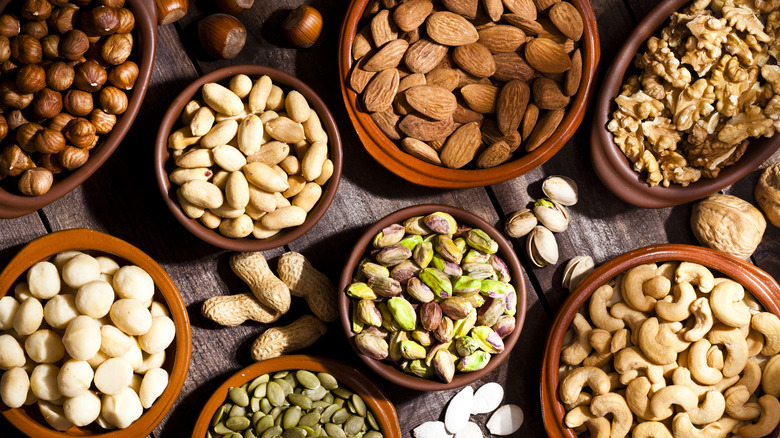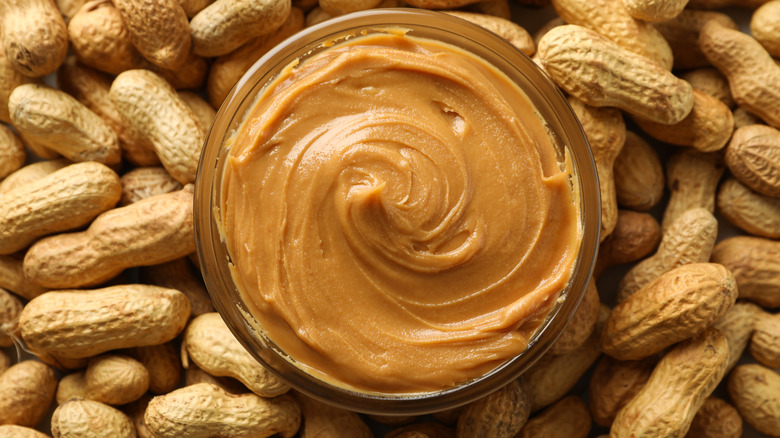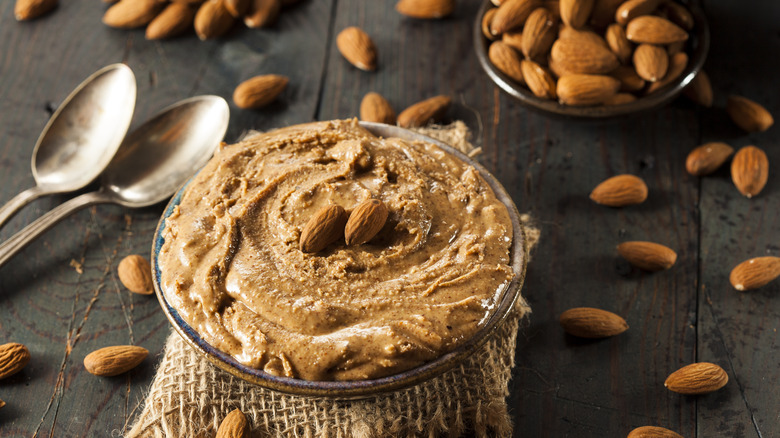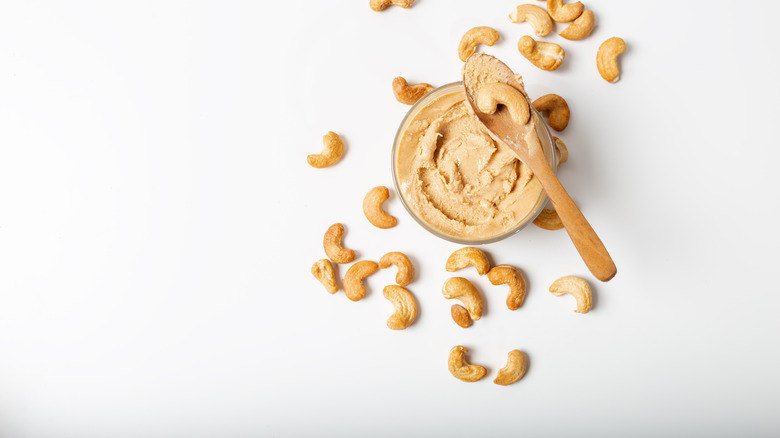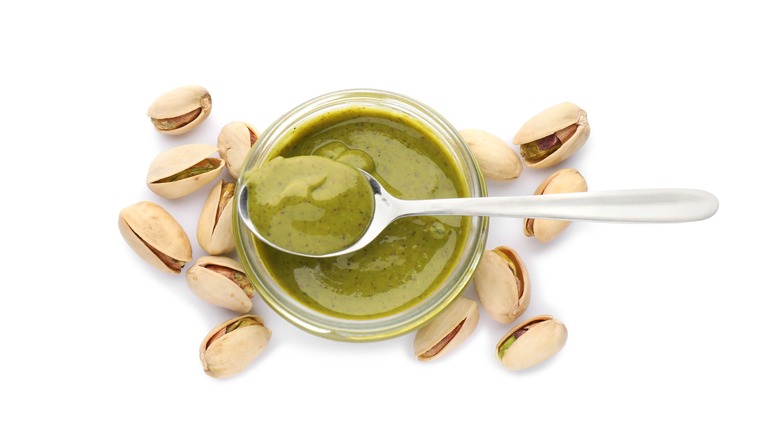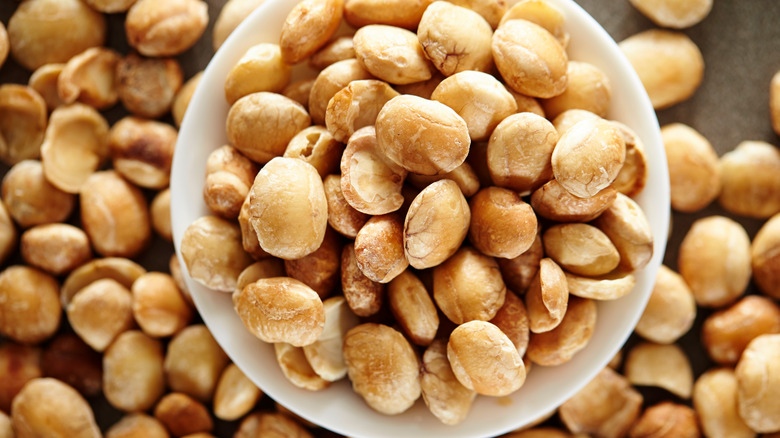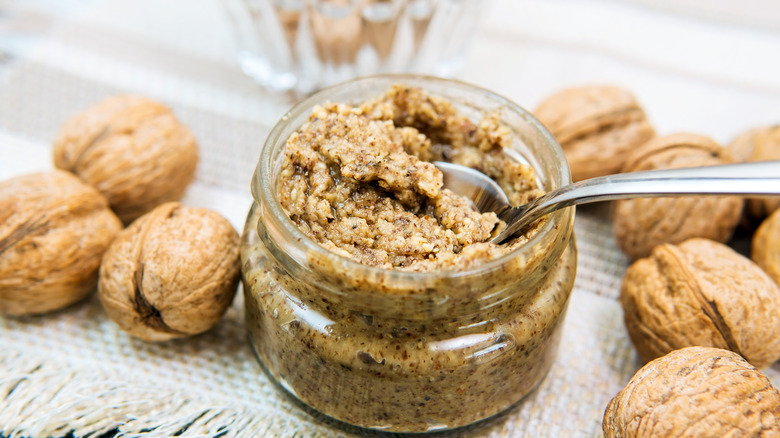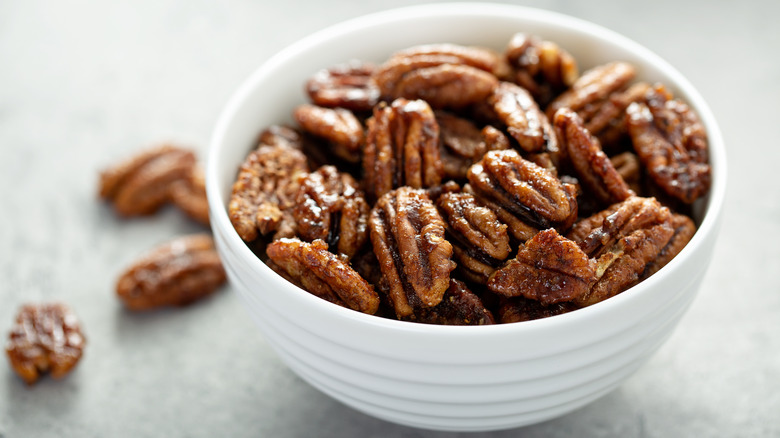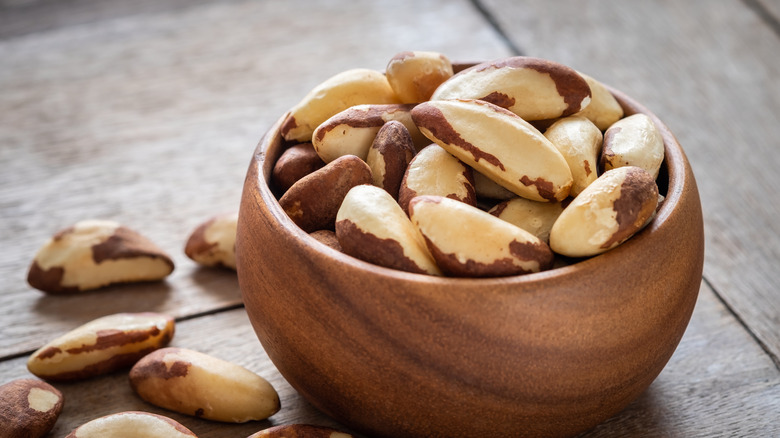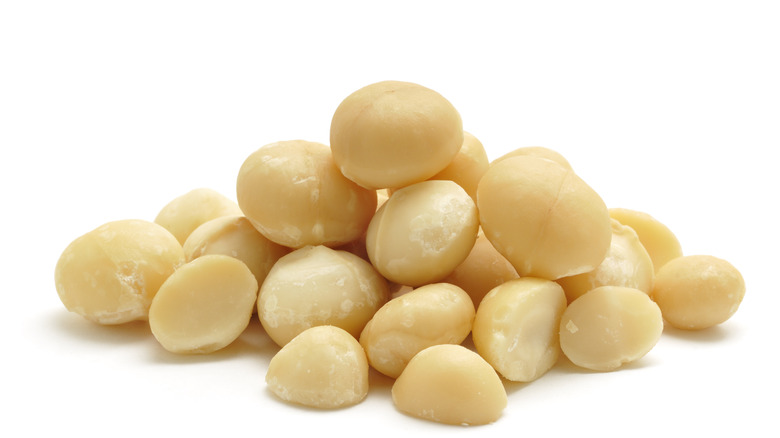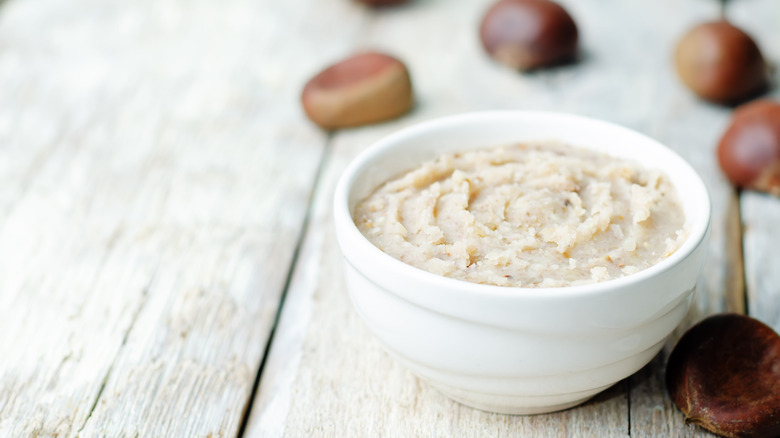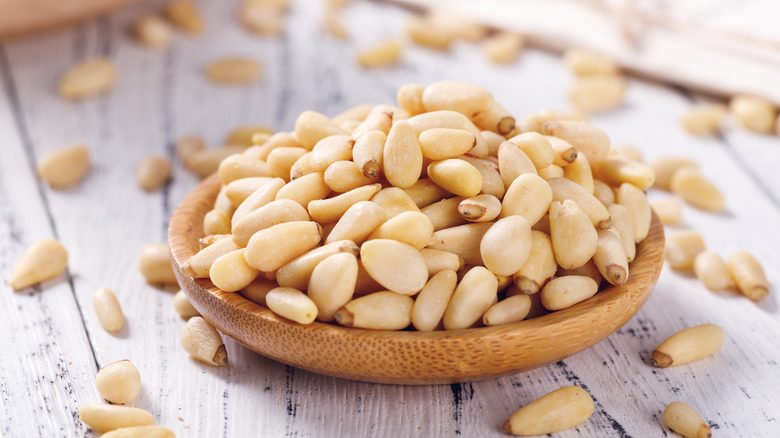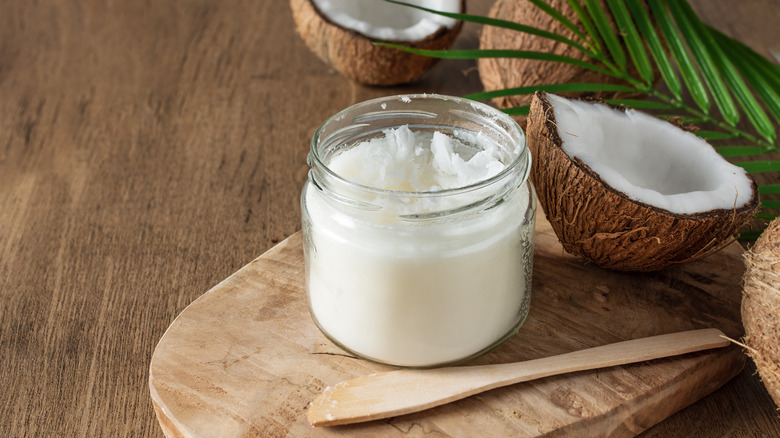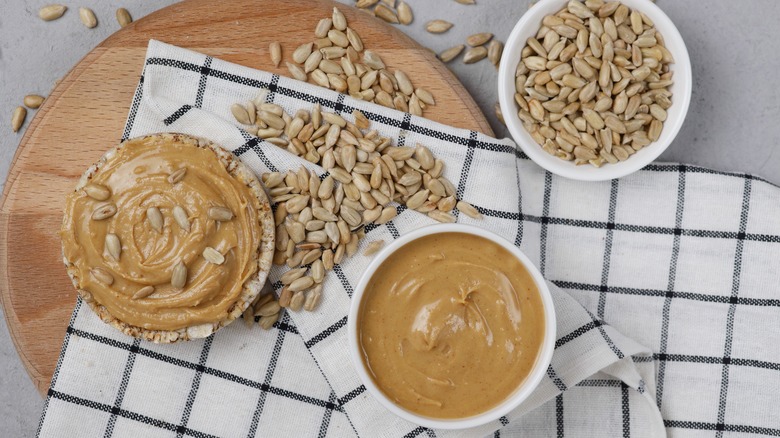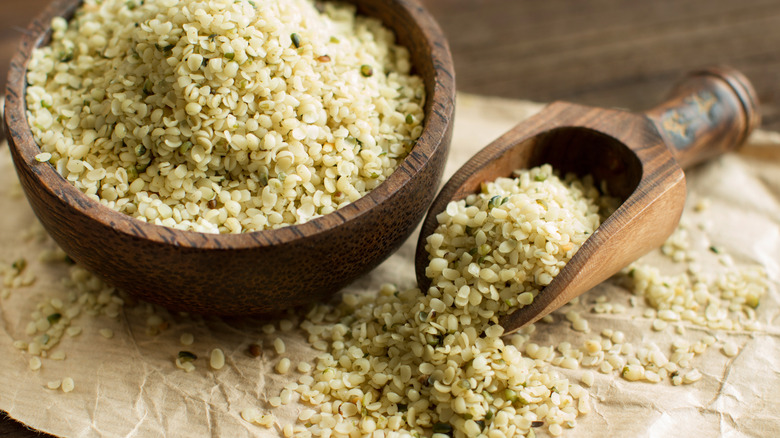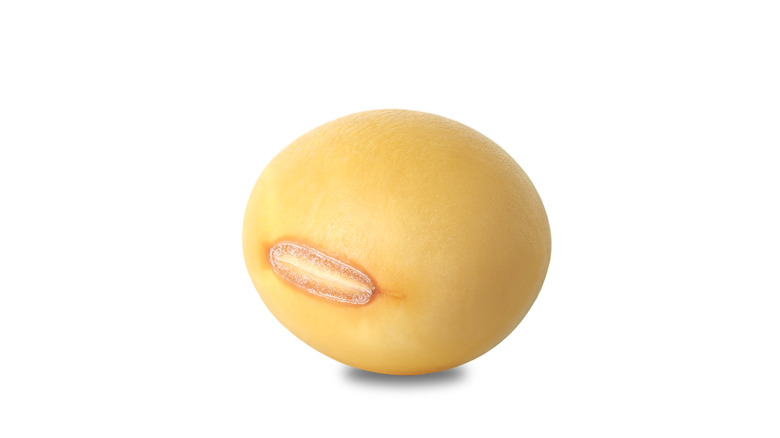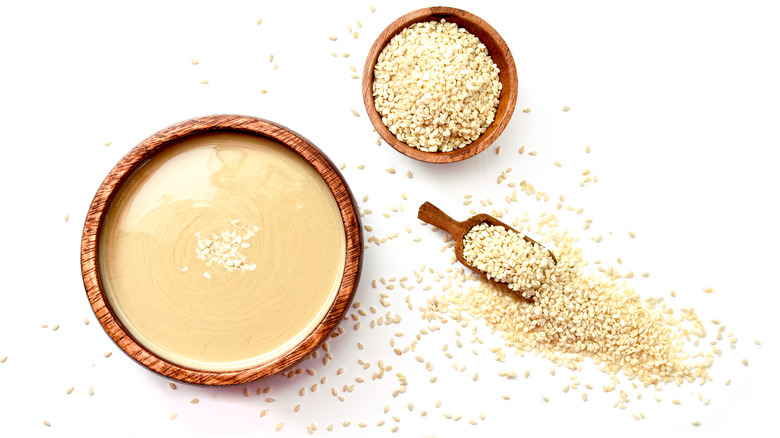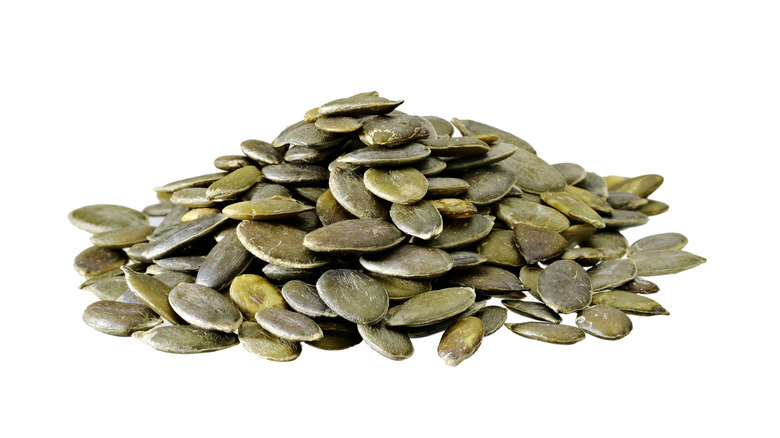The Ultimate Guide To Nut Butters
Generations of Americans grew up with PB&J, but these days, the culinary world has exploded with a veritable panoply of nut butters to supplant the humble peanut. From almond butter on sandwiches to walnut butter pasta sauces, to creamy cashew butter standing in as a vegan cheese sauce, to hazelnut butter forming the backbone of homemade Nutella, the variety and versatility of nut butters is pretty much unlimited.
But nut butters aren't just delicious. Nuts themselves are packed with protein, fiber, and healthy fats, making them the perfect snack or sandwich filler to keep you full and sated all day long. And, depending on the nut, they bring all manner of nutrients to the table, including vitamin B, phosphorus, zinc, and vitamin E. The category of "nut" butters also, believe it or not, goes beyond nuts. In addition to peanuts themselves — which, despite their name, are actually legumes – seeds like sunflower or sesame and fruits like coconut and chestnut join the melee and provide both unique flavors and alternatives for those forced to avoid peanuts or tree nuts, which are common allergens.
In short, the world of nut butter is rife with variety and flavor. And this is the perfect place to begin to learn more.
Peanut butter
Peanut butter — which marks many people's first brush with the category of nut butters — may date back as far as the ancient Incas. At its core, peanut butter can be quite healthy. Peanuts, after all, are a good source of vitamin E, niacin, manganese, vitamin B6, and magnesium, not to mention copper, which some studies have shown can reduce the risk of both osteoporosis and heart disease. Given its filling nature and delicious flavor, it's no wonder that peanut butter has long been considered a health food and was popularized as a protein substitute at the turn of the 20th century for those who had a hard time chewing. It's become omnipresent in Army rations for its shelf-stability and sheer nutritional density.
But the reality is that whole generations of Americans grew up on a highly processed version of peanut butter. Boasting of a creamier texture and a sweeter flavor, these iterations of peanut butter also have lots more calories and may contain controversial ingredients like unsustainable palm oil. Choosing natural peanut butters ensures you reap all of the health benefits of this spread without the added fat and sugar.
Peanut butter can form the base of a creamy salad dressing, add protein to your smoothie or oatmeal, or lend a lovely, savory note to frostings for cakes. And of course, it makes the ideal sandwich base; it works superbly on its own, with banana or marshmallow fluff, or alongside its eternal bestie, jelly.
Almond butter
Almond butter may well be the most popular peanut butter alternative, as it has a similar flavor profile and a slightly healthier nutritional profile, boasting more vitamins, minerals, and fiber, albeit slightly less protein. And while some people pooh-pooh almonds as a particularly water-intensive crop, almond farmers have worked hard to reduce their water consumption by 33% in the past 20 years, rendering the nuts comparatively sustainable, especially relative to non-plant-based sources of protein.
Almond butter is slightly more expensive than peanut butter, though not nearly as costly as some other nut butters. And while there are some incredible almond butter brands out there, the added cost has led many to make their own almond butter at home, which allows cooks to control not just the level of salt in the finished butter, but also any other flavors like cinnamon, vanilla, or even sweeteners like maple syrup.
Almond butter is perhaps the best all-around stand-in for peanut butter, with a mild flavor that marries well with jelly. But almond butter can also be used in savory dishes, adding richness and protein to creamy soups, pasta sauces, and more.
Cashew butter
Cashews boast an incomparable creaminess and richness, so it's perhaps no surprise that they've recently become a contender for a new nut butter fave. Indeed, many of its culinary benefits stem from its lack of assertiveness. With a silky-smooth texture and mild, only slightly sweet flavor, cashew butter has become the ideal base for plant-based cream sauces and dips. For vegans, fan-favorite cashew cheese has major implications for all manner of casseroles and baked pastas that are usually reliant on dairy milk. And given the protein content of cashews, not to mention their rich nutritional profile with minerals like selenium, potassium, and iron, recipes that swap out dairy cheese for cashew cheese are often healthier to boot.
Cashew butter may be a bit pricier than some other nut butters out there but making it at home can cut costs a bit. And if you ask us, given the flavor and texture of cashew butter, it's well worth the extra expense.
Pistachio butter
Verdant pistachios are sweet and rich, and, particularly when roasted, they make one of the most heavenly nut butters you'll ever try. Pistachio butter isn't just a great source of healthy fats, antioxidants, and vitamins, but it's richer than many similar spreads in potassium and even melatonin, making it the perfect snack for those who are having a hard time getting enough shuteye.
Pistachio butter can be pretty expensive but given the softer texture of pistachios compared to other nuts, this butter is relatively easy to make at home, which can save you quite a bit of hard-earned cash. Some at-home butter grinders have found that it's hard to get the same bright green pistachio color as it is in some store brands. This may be due to the fact that some manufacturers, in an attempt to cut costs, rely on cheaper almonds and a touch of food coloring to get that bright verdant hue. True pistachio paste will be rather mottled in color, but by removing the papery skins before blitzing the pistachios in the food processor, you'll lend a naturally beautiful green color to the spread. Our recommendation: homemade pistachio butter on your favorite toast, topped with berries for an even more colorful and nutritious snack.
Hazelnut butter
Hazelnuts may be slightly lower in protein than other nuts, but they more than make up for the deficit with their rich flavor and bounty of other nutrients. These include healthy fats, vitamin E, fiber, antioxidants, and manganese.
You can find hazelnut butter in shops, but it's relatively easy and much cheaper to make at home; plus, that way, you can control the final color and texture of your butter. First, roast the hazelnuts for a deeper, richer flavor. If you want a more textured hazelnut butter with a slightly more full-bodied bitterness, leave the skins on. If you'd rather a lighter butter in both flavor and color, simply place the warm hazelnuts in a dish towel and rub them vigorously to loosen and remove the skins. Give them a blast in a food processor, and you're done.
Hazelnut butter can be used in place of peanut butter or almond butter in pretty much any recipe you can think of, but its best potential application may be as the base for your own homemade Nutella. Simply blitz soaked dates, hazelnut butter, cocoa powder, and a touch of plant milk in a food processor or high-powered blender until smooth, and you've got your own better-for-you plant-based spread to enjoy on toast, drizzled over porridge, or right off the spoon.
Sacha inchi butter
If you've never heard of sacha inchi nuts, you're not alone. And yet, with a flavor somewhat resembling that of a peanut with a touch more umami funk, sacha inchi definitely deserves its time in the limelight. A superfood indigenous to Peru, sacha inchi is technically a seed, not a nut, which grows in beautiful star-shaped pods. The seeds themselves are a complete protein packed with healthy fats, fiber, and antioxidants. And given that they're unrelated to either peanuts or tree nuts, sacha inchi butter makes a perfect alternative for those with nut or peanut allergies.
Sacha inchi nuts aren't as easy to find in shops as some of the other nuts on this list, but you can order them online to make sacha inchi butter at home, or you can purchase sacha inchi butter ready-made. Retailers tend to offer it in sweetened or unsweetened versions, as well as spiked with a touch of chocolate.
Walnut butter
Walnuts look a little like brains, which should clue you into one of their major health benefits — walnuts have been linked to improvements in brain health and memory. Other benefits of walnuts include anti-inflammatory and antioxidant properties shared by many other members of the nut family. With their rich, intense flavor, walnuts can be used like other nut butters. For instance, they can be spread on toast or stirred into smoothies. But walnuts also have enough flavor to stand up to savory preparations. Homemade walnut butter can form the base of a classic salsa di noci, a Northern Italian pasta sauce made from ground walnuts combined with Parmigiano-Reggiano cheese, olive oil, garlic, and bread to thicken it to a rich, creamy consistency. Walnut butter also boasts its own thickening properties, lending body to dressings, salads, and particularly salads also garnished with whole or chopped walnuts for a double dose of nutty flavor.
Pecan butter
If you want your breakfast to taste like Thanksgiving, look no further than homemade pecan butter. Blitzed in the food processor, heady pecan butter is perfect when drizzled over toast or porridge or blended into your smoothie to make your morning meal taste just like pecan pie.
The naturally soft texture of pecans makes this butter one of the easiest to master at home and given the not inconsiderable price of pecans and pre-made butters, that's not a bad thing. To make pecan butter at home, first toast or roast your pecans slightly to bring out all of their natural flavor. Then blast them in the food processor, at which point they'll quickly come together into a silky-smooth paste. While delicious all on its own, a pecan butter base is rife with possibilities for adding even more flavor. A dash of cinnamon? A drizzle of maple syrup? A touch of brown sugar? It's up to you.
Brazil nut butter
Brazil nuts might not be the most common nut — in fact, technically they're seeds — but they definitely make a worthwhile nut butter given their natural, well, butteriness. Plus, they're a highly nutritious superfood known to support thyroid function. Their richness in magnesium has led some experts to posit they may offer a natural method of combating migraines. Brazil nuts are also good sources of copper and one of the best sources of selenium you're likely to find.
That said, a word of caution: Too much of a good thing can be bad, and that holds doubly true for Brazil nuts — their selenium content can become toxic if you gorge yourself on Brazil nut butter. Seeing as just one Brazil nut has enough selenium to help you hit your recommended daily value, it's best to reserve your Brazil nut butter for special occasions or consider swirling it with another milder nut butter, like cashew or macadamia nut, to keep your selenium intake reasonable.
Macadamia nut butter
Creamy macadamia nuts are a heart-healthy base for homemade nut butter, with benefits that may include reduced risk of metabolic disorders and inflammation. Of course, macadamia nuts are also one of the more expensive nuts out there, due in large part to the intense labor required to hand-harvest and hand-crack the buttery nuts, meaning that macadamia nut butter may be another example of what we call a "sometimes food."
Given its mild flavor and creamy texture, macadamia nut butter can be used much like cashew butter, though given its expense, it's nice to let it shine rather than hide it behind more assertive flavors like the nutritional yeast that often transforms cashew butter into cashew cheese. Since macadamia nuts make for a perfect pair with white chocolate, they're an ideal dessert ingredient. Consider using macadamia nut butter in baking — as the creamy heart of a white chocolate sandwich cookie, for instance — to get the most out of its delicate flavor and creamy texture.
Chestnut butter
Despite boasting a wholly different flavor and texture than other nuts, chestnuts are indeed a true nut — and they make for a delicious, albeit unique, butter. Lower in fat than other nuts like almonds or cashews, chestnuts also boast a far softer, almost starchy texture, which makes chestnut butter a creamy, pasty spread. Chestnut butter can either be enjoyed on its own or sweetened to create chestnut cream, a spread particularly beloved in France where it's often spiked with vanilla and stirred into plain yogurt or drizzled atop crêpes for a sweet treat. Chestnut butter can even be used in baking to create moist, aromatic cakes and cookies.
Chestnuts are a healthy choice, rich in vitamin C and other antioxidants. And given their lower fat content, they're also far lower in calories than other nuts, meaning that for those watching their weight, chestnuts can be a viable and delicious alternative to spreads like peanut butter or almond butter.
Pine nut butter
Given the price of pine nuts — more than three times that of almonds — pine nut butter is a true indulgence. But as a sometimes treat, pine nut butter can be an aromatic addition to your pantry, the ideal secret ingredient in recipes, savory or sweet. Stirred into pasta with a touch of garlic and basil or spread atop bruschetta before topping with tomatoes, pine nut butter can add creaminess and richness to main dishes. Its flavor also stands out when enjoyed in isolation. The rich, heady nuances of pine nut butter will also truly shine when spread on toast and topped with a drizzle of maple syrup.
Boasting loads of minerals and healthy fats, much like other nuts, pine nuts work to stabilize blood sugar and may even improve heart health. Pine nuts release even more flavor when they're toasted, so be sure to carefully coax these little nuts to a light golden brown before blitzing them in the food processor to create this creamy, dreamy spread.
Coconut butter
While the coconut is not a true nut in scientific terms, it can be used to make a rich, creamy butter that adds tropical flair to your pantry. Store-bought coconut butters are made with the flesh and oil of the coconut, rendering them smooth and rich. You can also make your own at home by using shredded coconut. Toast the coconut shreds before blending them in a high-speed blender or food processor. It may take more time than other nut butters to reach a smooth texture, but the resulting butter is a delicious treat to enjoy simply spread on toast or as a base for sweet treats like a heavenly dairy-free fudge.
Coconuts are high in fiber and healthy fats, not to mention minerals like manganese, copper, and iron, and they lend all of these health benefits to coconut butter. Coconut also has natural antibacterial properties as well as antioxidants to promote immune system health. Be mindful of added sugar in coconut butters or in the desiccated coconut used in the base of homemade butters, which can turn this healthy treat into an only-sometimes treat.
Sunflower seed butter
SunButter – with sunflower seeds as its main ingredient — is both peanut and tree nut-free, making it a delicious alternative for those with nut allergies, or those simply looking for a sandwich spread that can be brought into allergen-free schools and workspaces. And it's not just a trendy substitute — sunflowers have long been cultivated in the Americas, with seeds providing a source of healthy fats to folks for over 3,000 years. Today, their earthy, umami-rich flavor — which proved a tough sell when the first sunflower seed butters were marketed in the '80s — has become a beloved addition to sandwiches, baked goods, and more. That a few brands, SunButter among them, produce chocolate-flavored versions of the spread will certainly help those having a hard time getting used to the richer flavor. And seeing as sunflower butter is rich in zinc, heart-healthy fats, and protein, it's also a healthful, filling choice perfect for active kids and busy adults.
Hemp seed butter
Hemp seeds are yet another earthier seed with a savory, nutty flavor. Despite coming from the same family as cannabis, hemp seeds do not have any psychotropic properties, but they are out of this world in terms of health benefits. Rich in minerals and antioxidants, hemp seeds have been linked to reduced risk of heart disease, improved digestion, and even reduced PMS symptoms thanks to the presence of gamma-Linolenic acid, which reduces the effects of prolactin, a hormone responsible for symptoms like irritability, bloating, and even depression.
Hemp seeds are softer than many other nuts and seeds on this list, meaning that homemade hemp seed butter is fairly quick to make. In just five to six minutes in a high-powered blender, you should have a rich, creamy butter with a beautiful green color. While hemp seed butter can certainly be used like other nut butters on toast, especially when sweetened or spiked with cinnamon, it's particularly lovely when enjoyed in savory preparations seasoned with herbs, salt, and maybe a touch of garlic and spread on crackers in lieu of a garlic cheese spread.
Soy nut butter
Much like peanuts, soybeans are yet another legume that, when toasted, lend themselves to being transformed into butter quite beautifully. With a roasted, umami-rich flavor, soy butter boasts much of the same flavor as peanut butter. And it's not too difficult to make at home.
That said, unlike many of the other nut butters on this list, soy butter does take a bit more work than simply popping the beans in the blender. Soybeans should first be roasted until golden brown, then combined with a touch of neutral oil, which will help them blend up nice and creamy. It may look as though it's taking a very long time for the blender to get blending; depending on the power of your machine, it may be a good idea to pause every once in a while to let it cool down. But patience will pay off, with a richly flavored paste that's allergen-friendly and just as protein rich as peanut butter.
Tahini (sesame seed butter)
What is tahini if not sesame seed butter by another name? This popular Middle Eastern ingredient is made by blitzing sesame seeds into a creamy paste. It has recently become a bit of a darling of the culinary world, featured not only in time-tested recipes like hummus or baba ghanoush but also in anything from salad dressings to sauces. It works wonderfully as a mayo substitute, with a creamy texture and mild flavor and it can even add creaminess to homemade pesto.
Tahini is chock full of nutrients ranging from healthy fats to vitamins to minerals. A great source of phosphorous and manganese, tahini is a supercharged ingredient for the promotion of good bone health, and with its wealth of B vitamins and monounsaturated fatty acids, it's excellent for promoting energy and reducing inflammation. Darker versions of sesame butter like Chinese sesame paste may be made with roasted sesame seeds for an even deeper flavor.
Pumpkin seed butter
Pumpkin seeds are yet another non-nut that lend themselves well to nut butter treatment. The seeds make a particularly beautiful green-hued butter that's allergen-safe and nutritious, chock full of protein and trace minerals. When making pumpkin seed butter at home, it's essential to start with hulled pumpkin seeds — unhulled seeds won't just make your pumpkin seed butter gritty; they might even prove too much for your blender or food processor. After a slow start encouraged with a bit of neutral oil, the pumpkin seeds will blend into a silky butter with a mild, earthy, slightly sweet flavor.
While pumpkin seed butter stands in wonderfully for other nut butters, you can also have a bit of fun by pairing it with pumpkin flesh. Roasted cubes of pumpkin can adorn a slice of toast spread with green pumpkin seed butter for a colorful breakfast or lunch that's perfect for fall. Or you could drizzle a bowl of hearty pumpkin oatmeal with some of the butter for an added kick of protein, healthy fat, and color.
